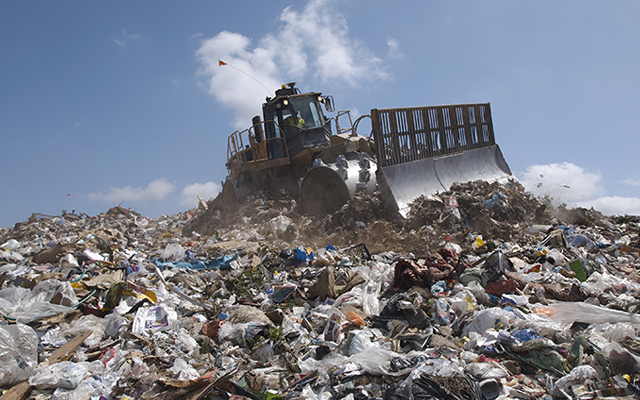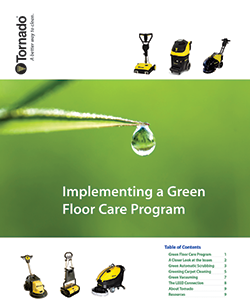Waste Not, Want Not
Words and phrases like “sustainable,” “green initiative,” and “zero waste”—once used mostly by eco-conscious extremists—are now part of the common vernacular. Cleaning up the planet is a common goal today, and the janitorial movement is leading the charge.
Reducing waste is one important way BSCs, senior housekeeping staff, and facility managers can reduce the negative environmental impacts of their work and their buildings. Waste comes in many forms, from the physical stuff that gets shoveled into landfills to unnecessary labor hours that drain budgets and divert resources. Here are a few ways to cut back on waste to better the planet (and the bottom line).
Champion a recycling program
Most of us know recycling is good for the environment, yet many businesses still aren’t doing it. Unfortunately, a recycling program can be a hard sell when a client or management sees it as an unnecessary use of time. To combat resistance, present the idea along with plenty of facts and figures.
- Compare rates and services of several waste management companies in your area.
- Find out whether the facility qualifies for tax incentives or grants that provide a financial return for green efforts.
- Do a waste audit of your facility to learn exactly what’s being discarded and at what cost.
- If numbers don’t sway management, go rogue. Start small with a few bins in high-traffic areas and see what happens.
For a full guide to getting a recycling program going in your building, read Green is the new Black: Six Steps to Successful Recycling Program.
Switch up your supplies
Disposable and consumable supplies are a large part of any cleaning operation’s budget, and they offer a huge opportunity for reducing waste. In a commercial, industrial, or institutional building, even small changes can have an enormous impact on waste.
- Paper towels. Installing high-speed air dryers in the bathrooms of a large U.S. Department of Agriculture facility resulted in a 50 percent reduction in the use of paper towels and eliminated two tons of waste in one year. This one change reduced trash pickups from five to four a week, saving $30,000 in Dumpster fees.
- Chemicals. Manually measuring cleaners results in a big “glug factor.” Instead, use concentrated chemicals with an automated dilution-control machine. The proportioning system dilutes chemicals at optimum concentration, maximizing effectiveness and cutting waste from spills and overuse. Also, replace redundant products with multi-purpose cleaning agents to reduce purchasing, storage, and training.
- Trash liners. Low-quality or ill-fitting garbage bags are a false economy. Faced with flimsy bags, workers either waste time dealing with tears, leaks, and spills, or resort to wasteful double bagging. Buy stronger fit-for-purpose bags for each application to reduce your long-term spend.
Overhaul your equipment and systems
Using the best tools for the job is an obvious way to prevent wasted labor hours. Too often, however, we settle for “good enough” and miss opportunities to improve. Deployed strategically, advances in technology and equipment can drastically reduce waste.
Most budgets don’t allow for a complete equipment overhaul—and trashing everything to start over probably isn’t the most environmentally friendly choice anyway. Letting your equipment reach the end of its useful life before replacing it with more a efficient model is generally the least wasteful option. When it’s time for replacements, however, consider the following:
- Low-Moisture units can cut chemical and water use dramatically. Orbital automatic scrubbers and floor machines are examples of low-moisture machines. They can actually remove top coats of floor finish without the use of strong chemicals, allowing the floor to be recoated while avoiding the need to chemical strip all of the original coats off. Cylindrical brush machines are another example of low-moisture machines that typically use much less water than traditional disc or rotary machines.
- Battery-operated equipment. Switching to battery-operated backpack vacuums can save your crews many precious minutes of unplugging and replugging machines. Plus, the ergonomic benefits of portable equipment can also cut time lost to strain and injury. For more information, see How Battery Technology is Changing Cleaning Productivity.
- Computer and web-based technology. The right tech choices can save you a huge amount of time and cut down on paper use. Work-order programs speed up billing, time-tracking apps reduce time spent managing schedules, and workloading software make it easy to find inefficiencies in your operation. (Learn more about the benefits of workloading in Take the Guesswork Out of Estimating Cleaning Budgets.)
Look for opportunities to conserve water
With large parts of the country facing severe droughts and utility costs at an all-time high, water conservation is an area of immediate concern for many businesses. Luckily, there are many simple steps janitorial crews can take to reduce water waste.
- Change to microfiber mops. Cleaning floors is water- and labor-intensive; replacing conventional cotton mop heads with microfiber can make a huge difference on both counts. According to the Environmental Protection Agency, microfiber mops use up to 90 percent less water and chemicals. They’re also more ergonomic and more efficient, allowing crews to clean more floors in less time.
- Use matting inside and outside entrances. Matting drastically cuts down on the amount of dirt that enters a building, which reduces the frequency of floor washing.
- Replace hoses with power washers or water brooms. A traditional hose without a shut-off nozzle can use up to 20 gallons of water a minute. Cleaning a surface with a pressure washer reduces water usage by up to 70 percent, and using a water broom cuts water waste by 90 percent.
- Report leaky pipes and fixtures to maintenance immediately. It’s easy to overlook a dribble here or there, but leaks are a major source of water waste. Repairing these leaks could cut your building’s water consumption by 10 percent annually.
Consider day cleaning
Cleaning after hours when building occupants have gone home for the night is not the only option. With the right training, your crews can get cleaning done during business hours. Making the switch to day cleaning takes some effort and investment, but the efficiency rewards are impressive.
- Less energy use. It’s possible to cut a facility’s power bill by 10 percent just by turning off the lights at night and moving cleaning work to daylight hours.
- More efficient workers with less management oversight. Working in broad daylight and surrounded by the building’s occupants helps cleaning crews get more done faster.
- Easier recruitment and better employee retention. Daylight shifts are much more appealing to workers and offer highly increased job satisfaction. Finding and training new staff is one of the most expensive and time-consuming parts of any BSC’s operation, so day cleaning can create considerable financial savings.
Cleaning professionals can play a vital role in reducing a facility’s waste. Encourage janitors to start conversations, offer information, and foster an attitude of conservation in a building. Empower your crew to look for greener options and reward them for their efforts. There are endless ways for cleaning staff to help facilities move towards greener operations, but even implementing a few of the suggestions above will make a big difference.
Implementing a Green Floor Care Program
A Closer Look at the Issues
To fully understand Green Cleaning in general, Green Floor Care in particular, and why they are both so important, one must take a closer look at the environmental impact of floor care. Learn more about some of the concerns raised by the use of traditional cleaning products and practices.


